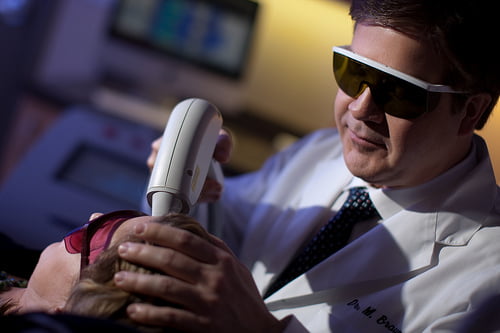Female facial hair is one of the last great beauty taboos. We still don’t like to discuss it, but are painfully conscious of its effects.
Glossy magazines and adverts frequently airbrush out any hint of facial fluff, while high-definition television and films mean that any woman in the public eye is threaded or waxed to baby-bottom smoothness before stepping in front of the camera.
So it’s no wonder techniques that promise permanent hair removal have become popular over the past few years, with laser hair removal in particular, lauded for its quick and efficient results.
Laser hair removal became commercially available in the late Nineties and, as technology improved and prices dropped, it became increasingly widespread. Because hairs could be targeted only in the anagen (growth) stage, and because not all hairs are in the growth stage at the same time, it requires multiple treatments.
However, after eight to ten treatments at four to six week intervals, most patients are hair-free.
But while those with dark hair raved about it, people with white, blonde, red or grey hair were not so lucky. The technology isn’t effective on pale hair or on any kind of hair if you have dark skin. Simply put, laser hair removal works because the light energy emitted by the laser is reflected by the pale skin around the hair, but absorbed by the darker pigment in the hair.
Pale hair doesn’t absorb the energy, while dark skin absorbs too much of it, resulting in burns. But when a dark hair surrounded by pale skin absorbs the light energy, it is transformed into heat, which destroys the hair and the root, damaging the follicle and preventing regrowth.
Various unsuccessful attempts have been made to adapt laser technology, so it works with paler hair. One of these involved dyeing hairs with squid ink before using the laser, but the ink didn’t create the depth of pigment required. As a result, the hairs would be destroyed, but subsequently regrew.
However, a revolutionary new form of hair removal technology developed in Israel now means blondes can also be permanently hair-free.
Distributed under the brand name Applisonix, the treatment uses ultrasound, which is delivered through a tweezers-like device.
The ultrasound waves travel through each hair right down to the root, where they are converted into heat energy and — as with laser hair removal — destroy the hair, so it falls out instantly. The waves damage the follicle so hair cannot regrow.
Sign up for our free weekly newsletter
SubscribeWest London facialist Katherine Jackson is one of the first people in the UK to use the technology.
“I’ve been using it for about a year”, she says. “And the results have been fantastic. There was a huge demand for something that would tackle pale hairs. And, unlike laser treatment, you don’t have to stay out of the sun, or wear sunblock afterwards”.
There are drawbacks though. As with electrolysis, only one hair can be tackled at a time, making it unsuitable for large areas.
And as only hairs that are long enough to be grasped by the tweezers can be treated, multiple treatments are needed. Katherine suggests six to eight sessions around four weeks apart.
However, unlike either electrolysis or laser treatments, those who have tried it say that thanks to the fact that the ultrasound waves don’t affect the surrounding skin, it’s pretty much pain-free.
Linda Jones, 61, from West London, has been having Applisonix treatments on her face for around three months.
“It feels a bit like the hairs are being plucked, but it takes no more than about 20 minutes and there’s no redness afterwards. I’m really pleased with the results I’m seeing already”.
Dr Sean Lanigan, the Group Medical Director of skin clinics, was involved in early research into Applisonix and believes the technology has more to offer. “Manufacturers are looking at adapting the technology, so you could treat multiple hairs at the same time and also at some form of home-use device”, he says.
If the makers of Applisonix get their way, we could soon all be talking about beauty’s biggest taboo.
…
To read the full article, click here.
Via Daily Mail
Photo by Vancouver Laser & Skincare Centre
Related posts

Israeli Medical Technologies That Could Change The World

Harnessing Our Own Bodies For Side Effect-Free Weight Loss

Missing Protein Could Unlock Treatment For Aggressive Lung Cancer




Facebook comments